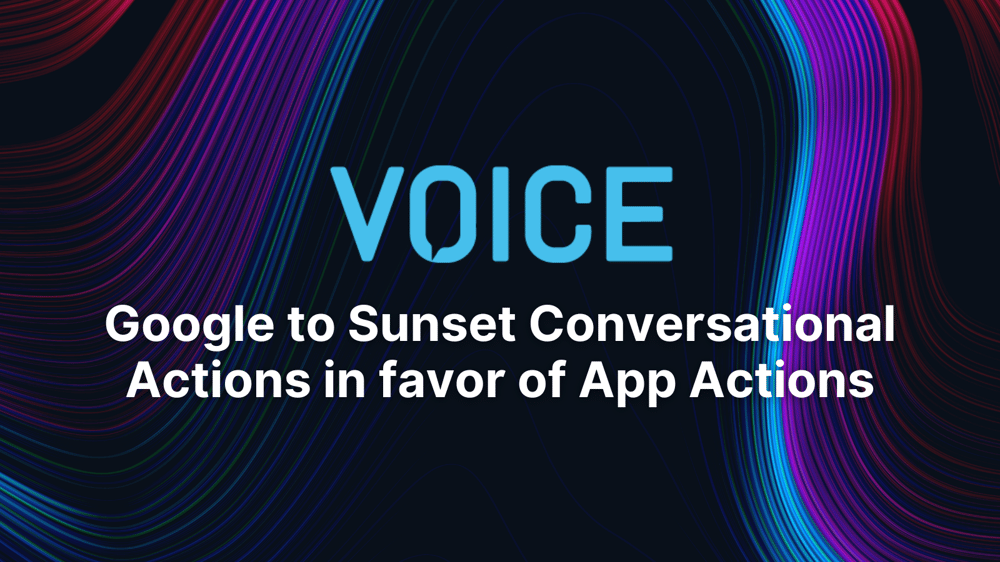Google to Sunset Conversational Actions in favor of App Actions
Modev News VOICE Summit 22-06-30 Modev Staff Writers 4 min read

Google just announced that it will sunset Conversational Actions on Android in favor of App Actions. Both have coexisted for some time now within Android and will continue to do so until June 2023. After that, only App Actions will be available to create voice experiences in Android. This impacts voice capabilities across all Android devices, like mobile, auto, wearables, and other devices in the home (smart speakers, for example).
But what exactly are the differences between Conversational Actions and App Actions? And what does this change mean for developers? That's what we're going to tackle in this post.
What are Conversational Actions?
Conversational Actions enable you to extend Google Assistant functionality with your own conversational interfaces allowing your users to access your products and services. Conversational Actions rely on Google Assistant's natural language understanding (NLU) engine to process the user's natural language input and perform actions and tasks based on that input.
Conversational Actions have three main components:
Invocation: Invocations determine how users let Google Assistant know they want to start a conversation using one of your defined Conversational Actions
Conversation: Conversations determine the flow of the exchange between the user and Google Assistant. Conversations are built using intents, types, scenes, and prompts. Taken together, intents, types, scenes, and prompts define the structure of the conversation - how the user makes queries and what gets fed back to them.
Fulfillment: Fulfillments are web services that can communicate with your Conversational Actions using webhooks. They enable you to conduct data validation or call external web services, among other things. Fulfillments are entirely optional when building Conversational Actions.
Conversational Actions are required to allow users to access your app's functionality using voice. That functionality must be defined within the Conversational Actions for it to be accessed using voice. Conversational Actions cannot "make calls" to the existing functionality - the functionality must be duplicated within the Conversational Action.
What are App Actions?
Unlike Conversational Actions, App Actions actually extend your existing in-app functionality to Google Assistant, giving users voice access to your app's features. App Actions are enabled by specifying one of the many built-in intents (BII) in your shortcuts.xml file. BIIs model common ways in which users express their queries.
When a user triggers an App Action, Google Assistant will match the query to the BII(s) you specified. It then generates an Android Intent (based on your <capability> tags in shortcuts.xml) and launches your app at the requested page/screen or displays an Android widget based on the requested functionality.
With App Actions, Google Assistant does all the heavy lifting. It analyses the natural language input, matches it to your BII, generates an Android Intent, and fulfills the request by opening your app at the appropriate screen (or displays a widget).
Why privilege App Actions over Conversational Actions?
The answer to that question is two-fold. First, user feedback informs Google that users want to engage with their apps using their voice. Second, based on its developer feedback, Google is aware that developers want to build upon the existing functionality in their apps rather than have to code separate voice experiences for pre existing features.
App Actions are the answer to both concerns. They enable deeper integration with apps' functionality to provide users with rich and natural voice experiences. And they allow developers to leverage their apps' existing features to convert them to voice experiences without having to code everything from scratch.
As Rebecca Nathanson, Director of Product from the Assistant Integration Developer Platform, stated, "Based on analytics and feedback from users and developers, Google has decided App Actions is the best path forward for delivering the biggest ROI for developers. One of the things that we've heard from our users is that while voice-first is a great addition to the world of technology when it's detached from all the other ways that users interact with the services and apps that they're already familiar with and love and use on a daily basis, it's not nearly as compelling for them. At the same time, we heard from developers that it's challenging to create a voice experience using Conversational Actions as a standalone product. You have to start from scratch every single time.
Wrapping Up
So those are the differences between Conversational Actions and App Actions. And I feel that just laying out their differences, as we did, makes it pretty clear that Google is making the right decision. App Actions provide better experiences and make developers' lives easier.
Also, AI-powered voice tech is still somewhat new. That means that as the industry grows, new things suddenly become possible. And to capitalize on those possibilities, changes need to occur, so those who build these experiences have the right tools.
That's why Google is making that change, and we look forward to seeing what kinds of new voice experiences that change will provide.
About Modev
Modev was founded in 2008 on the simple belief that human connection is vital in the era of digital transformation. Today, Modev produces market-leading events such as VOICE Global, presented by Google Assistant, VOICE Summit, and the award-winning VOICE Talks internet talk show. Modev staff, better known as "Modevators," include community building and transformation experts worldwide. To learn more about Modev, and the breadth of events offered live and virtually, visit modev.com.